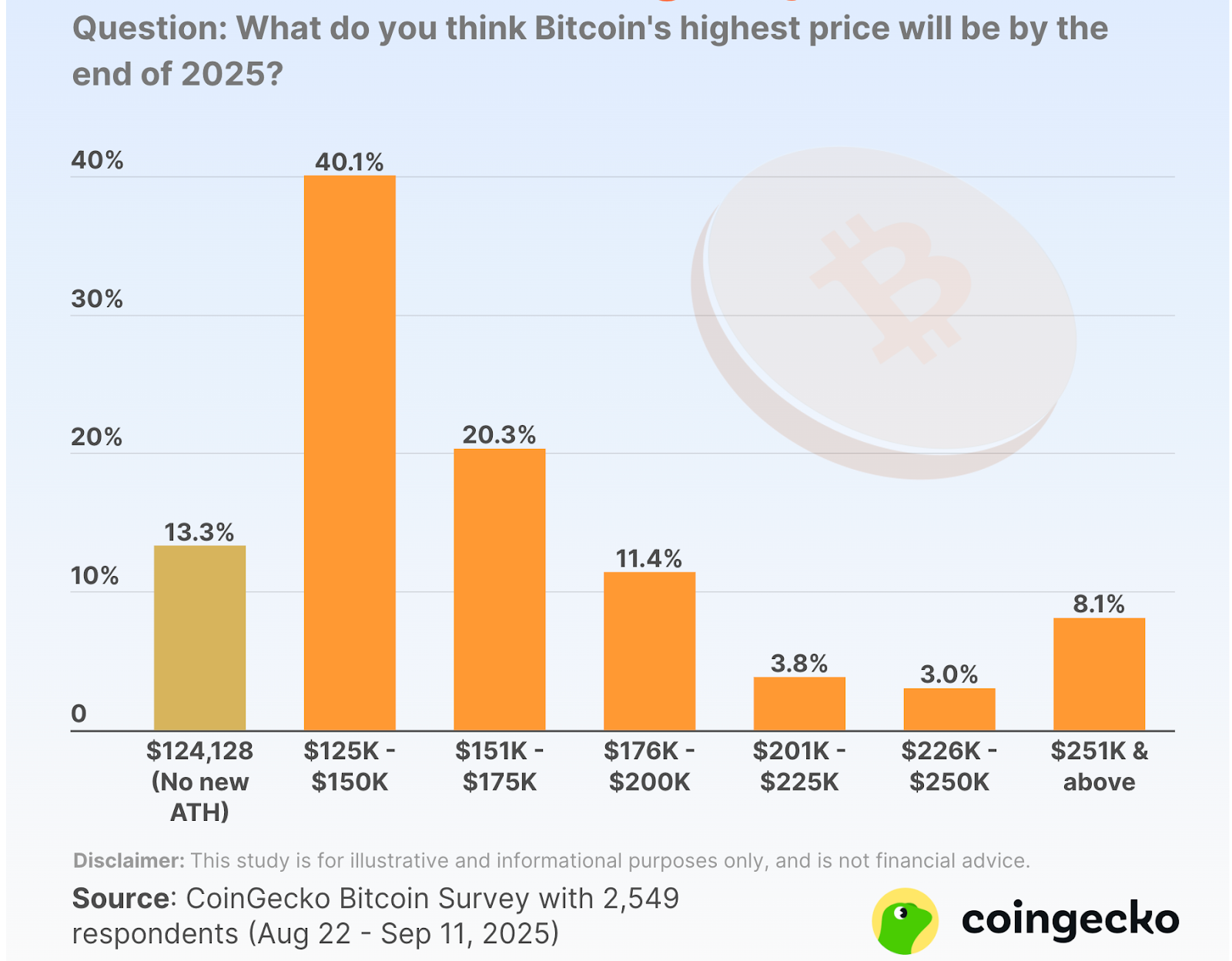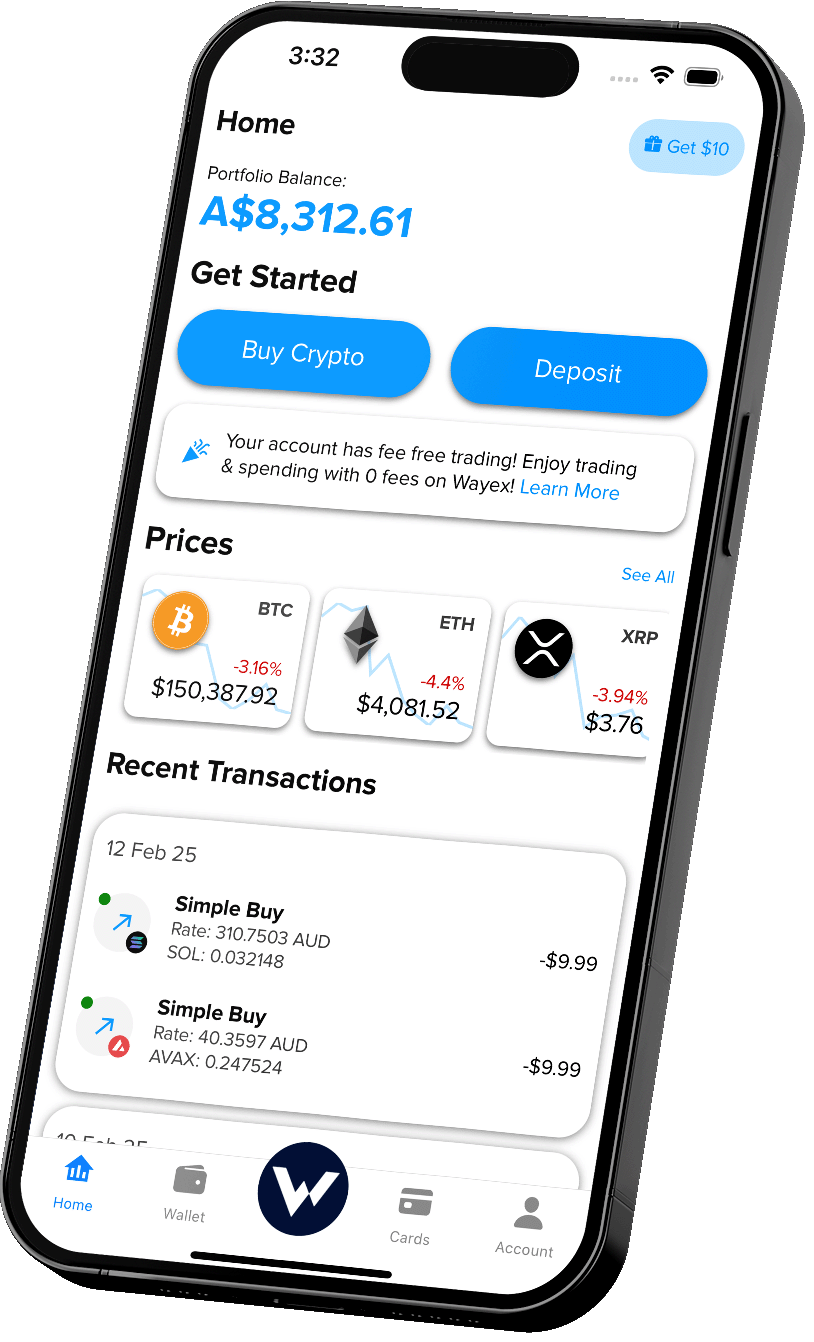The past week in crypto has been defined by shifting sentiment, major policy moves, and big developments in stablecoins. Bitcoin and Ethereum entered the week with cautious optimism, climbing above US$116,000 (AUD $175,000) as options markets showed easing downside fears. That optimism was tested when the US Federal Reserve confirmed a 25 basis point rate cut, sending Bitcoin back below US$115,000 (AUD$174,000) and leaving traders debating between short-term caution and long-term opportunity.
This backdrop has reignited talk of altcoin season, with analysts noting that easier monetary conditions and strong equity markets could push liquidity into higher-risk assets such as Ethereum, Solana, Chainlink, and XRP. A CoinGecko survey added to the bullish tone, showing nearly 87% of respondents expect Bitcoin to reach a new all-time high this year, with even non-holders sharing that view.
In stablecoins, Tether announced the launch of USAT, a US-regulated token under the GENIUS Act, while Hyperliquid’s USDH auction ended with Native Markets, backed by Stripe’s Bridge, taking the lead role. Meanwhile, CoinTelegraph outlined a new editorial stance of sceptical advocacy, pledging to balance optimism for blockchain with greater accountability and oversight.
Together, these developments highlight a market balancing optimism and caution as it prepares for the next phase of growth.
What’s Happening On The Wayex Platform This Week


Pricing Speculation: Where’s it at?
Bitcoin and Ethereum saw improved sentiment last week as downside fears in the options market eased, with call/put skews for both assets shifting back toward neutral. BTC gained around 4% to trade above US$116,000 (AUD price Jess), while ETH climbed about 8% toward US$4,650 (AUD).
Coindesk noted that options data reflected this optimism: SOL calls traded at a premium over puts, showing bullish positioning across altcoins, while ETH options also pointed to easing downside risks. Still, analysts noted that breaking back above ETH’s prior highs near US$5,000 could take longer if the Fed delivered only the smaller cut. For exchanges, the environment underscored the need to prepare for heightened volatility, as any deviation from market expectations could trigger sharp price swings. Overall, BTC and ETH entered the week with cautious optimism, supported by macro speculation but still highly sensitive to the Fed’s ultimate policy direction.
This speculation was before the Fed Rate cut was announced this morning.
Bitcoin slipped below US$115,000 (AUD$174,000) after the US Federal Reserve delivered a widely expected 25 basis point rate cut, lowering its benchmark rate to 4.0%–4.25%. While the cut confirmed a dovish policy shift, the reaction in crypto markets has been muted, suggesting much of the move was already priced in. The Fed also signalled that as much as 50 bps of further cuts could come before the end of 2025, adding longer-term optimism for risk assets.
In derivatives markets, open interest in Bitcoin futures surged, showing traders are positioning for higher volatility, but spot market demand continues to lag. This divergence signals that the rally is being driven more by leveraged speculation than by strong buying pressure. Analysts warn of a potential “sell the news” effect, where prices weaken after the expected rate cut materialises.
For now, Bitcoin’s struggle to hold above US$115,000 (AUD $174,000) reflects cautious sentiment, with investors weighing whether looser monetary policy will be enough to sustain momentum. At the same time, altcoins are watching closely.
Altcoin Autumn - Have we cried wolf too many times?
According to a recent analysis shared on “the time has come” for what could be an explosive altcoin season. The report highlights that this cycle is unusual, as the US Federal Reserve has already voted to cut rates, a policy shift that often fuels risk-on assets like crypto. As reported in CoinTelegraph “rate cuts typically happen when stock valuations are low or economic growth is weak, but this time the S&P 500 is near all-time highs, with valuations rivalling the dot-com bubble and even 1929.”

The piece explains that this unique setup, with rate cuts combined with strong GDP growth and elevated equity markets, could funnel liquidity into speculative assets such as altcoins. Bitcoin and gold have already been beneficiaries of this shift, but the article argues the opportunity may be even greater for altcoins. “Capital will inevitably look for higher returns,” the analysis suggests, pointing to assets like Ethereum, Chainlink, XRP, and AI-linked tokens as potential leaders.
While near-term volatility remains a risk, the decisive move by the US Federal Reserve has reinforced optimism that conditions are lining up for the much-anticipated altcoin season. As the article concludes, “this may be the kind of rare moment that investors only recognise in hindsight. But as our subject title says, “Altcoin season” has been cried many times, but maybe, just maybe, it might be here.
The US Fed Rate cut could prove significant for altcoins. This policy shift could prove pivotal. While Bitcoin’s short-term struggle highlights cautious sentiment, easier monetary conditions tend to benefit higher-beta assets more strongly. Ethereum and Solana, for example, are well-positioned to attract liquidity inflows if investors search for higher returns beyond Bitcoin.
Right now, analysts seem to be debating between a crash and a bull run - so take that as you will.
CoinGecko Pricing Speculation Survey
A new CoinGecko survey shows that optimism around Bitcoin remains extremely high heading into the final months of 2025. Out of 2,549 respondents, 86.7% believe Bitcoin will set a new all-time high before the year's end, surpassing its current peak of US$124,128 (AUD $187,000).

The survey data shows that optimism around Bitcoin isn’t limited to those holding it. Among respondents with no BTC exposure, 82.8% still believe a new all-time high is coming this year. That includes 205 of 250 people who have never owned Bitcoin, and 304 of 365 former holders.
Even without skin in the game, their forecasts lined up with current holders, showing that market sentiment is being driven by broader confidence in Bitcoin’s role, not just personal portfolios. And it’s important to note that this data was compiled before the Bitcoin Strategic Reserve roundtable attended by notable crypto heavyweights and US crypto-friendly senators.
If you are interested in seeing the full breakdown of the data, as well as their research parameters and sampling information, you can find that here.
Tether launches USDT
Tether has announced the launch of USAT, a new U.S.-based stablecoin set to debut by the end of 2025, marking a major step in expanding its presence in the American market. The initiative will be led by Bo Hines, a former White House adviser on digital assets, and the token will be issued through Anchorage Digital Bank, a nationally chartered trust bank. Unlike Tether’s flagship USDT, which already dominates the global market with over US$169 billion (AUD $254 billion) in capitalisation, USAT is designed to operate squarely within the U.S. regulatory framework established by the GENIUS Act. This law requires stablecoins to be backed by highly liquid assets such as U.S. dollars or Treasury bills, with monthly disclosures of reserves to ensure transparency. Anchorage Digital Bank and Cantor Fitzgerald are partnering in the venture, providing both trust and custody functions, while USAT will be headquartered in Charlotte, North Carolina. Tether emphasised that USDT will continue to comply with the new rules as a “foreign issuer,” while USAT is expected to serve as its fully regulated U.S. counterpart. With growing competition in the sector, including Circle’s IPO and heightened regulatory clarity, Tether’s move positions it to strengthen its hold on the stablecoin market and capture new opportunities in the U.S. financial system.
Hyperliquid USDH fist fight goes HAM
Hyperliquid, a high-performance DeFi trading platform, has just concluded a major auction to decide who would issue its native stablecoin, USDH. As reported by Elementus, the platform oversees about US$5.5 billion (AUD 8.3 billion) in USDC deposits, making the outcome critical since the winning issuer would control reserves, yield, and liquidity flows.
The bidding war drew heavyweight contenders, including MakerDAO’s Sky, Paxos, Frax, Ethena, Agora, backed by MoonPay, and Native Markets, which is supported by Stripe’s Bridge subsidiary. According to Elementus, each bidder offered different trade-offs around yield-sharing, regulatory backing, and integrations. Ultimately, validators voted in favour of Native Markets, which promised aggressive revenue-sharing, institutional partnerships, and strong reserve management.
As CryptoNews noted, this decision carries significant weight beyond Hyperliquid itself. Its deposits represent nearly 8% of all USDC in circulation, meaning the pivot to USDH could challenge Circle’s dominance in stablecoins. The auction also showcased a power shift: DeFi platforms can now negotiate directly with issuers instead of simply adopting existing stablecoins.
Competition in the stablecoin market is heating up. Issuers are now leaning on compliance credentials, transparent audits, and alliances with major payment firms like Stripe to differentiate themselves. Community governance was equally important, with validators actively shaping stablecoin economics through open voting. Although it's important to note that the “vote” did have some sceptics, with some in the crypto community up in arms about procedural unfairness.
But what’s next now? Key factors to watch will be the speed of USDC migration, transparency of reserve disclosures, and whether other protocols adopt similar auction-style issuer selections. Together, the insights from Elementus and CryptoNews make clear that Hyperliquid’s showdown is more than just a governance experiment. Rather, it signals a structural power shift in how liquidity, governance, and growth will shape the next phase of DeFi.
CoinTelegraph Editorial Note - let’s chat, yeah?
CoinTelegraph, a leading industry source, wrote an editorial note advising its community about the change in direction of its coverage. CoinTelegraph has announced a new editorial direction under the banner of “sceptical advocacy.” While reaffirming belief in blockchain, crypto, and Web3, the publication will put a stronger focus on ethics, responsibility, and critical oversight. The letter highlights the dual nature of the industry, with visionary builders alongside scams and exploitative models, and commits to spotlighting innovation while exposing misuse. Core values include pragmatic decentralisation, privacy, personal sovereignty, and digital ownership rights. Going forward, CoinTelegraph says it will act as a media ally, defending legitimacy, correcting misrepresentations, and pushing back against mainstream narratives that reduce crypto to hype or scandal.
As a big fan of CoinTelegraph, we applaud their transparency in telling us about these editorial policy amendments. Although we don’t expect the quality of their news to change, we do think it’s worthwhile to note this change in their reporting.
Things that made us laugh this week



Founders Corner
The Fed’s rate cut knocked Bitcoin back under US$115K, but instead of seeing weakness, I see resilience. Crypto is holding its ground even as global markets wobble, a sign it’s no longer the outlier but part of the financial mainstream.
The altcoin buzz does not seem to know if it is coming or going, but the lasting story is stablecoins. Tether’s USAT and Hyperliquid’s bold auction prove one thing: the world wants digital dollars it can actually use. Regulation is catching up, adoption is accelerating, and the infrastructure is being built right now.
Wayex is stepping right into this moment. We’re not chasing hype; we’re solving the real-world problem of turning stablecoins into money you can spend anywhere with the Wayex Visa Card. That’s not just a product launch, it’s the start of a new financial system.
**All information in this article is for informational purposes only. You should not construe any such information or other material as legal, tax, investment, financial, or other advice. Nothing contained herein shall constitute a solicitation, recommendation, endorsement, or offer by Wayex to invest, buy, or sell any coins, tokens, or other crypto assets. Any descriptions of Wayex products or features are merely for illustrative purposes. Past performance is not a guarantee or predictor of future performance. The value of crypto assets can increase or decrease, and you could lose all or a substantial amount of your purchase price. It is essential for you to do your research and due diligence to make the best possible judgement, as any purchases shall be your sole responsibility.
.png)









